
Project Title: Prosperity Gardens
Voluntary weekend workshop with outside professionals/facilitators + 2 three-week long modules (for credit), at the University of Illinois at Champaign-Urbana.
Number of students and level: Approximately 32 per three-week module, with 16 sophomores/16 juniors per module.
Target Audience: North First Street Community, Champaign/Urbana Community, University Community
Project Goals: Accelerate the amazing work Prosperity Gardens was already doing; craft a strong narrative to help Prosperity Gardens tell their story to the community; identify avenues for future economic sustainability. Finally, create less work – not more – for Nicole Bridges, the director of Prosperity Gardens.
Project Description
My teaching collaborator Eric Benson and myself wanted to introduce our graphic design students to how our discipline is more diverse than simply working for corporate clients. So we invited Little Things Lab from Detroit, MI (reallybigthings.org) and Amanda Buck, whose last work with as a senior designer with the Obama campaign, to help facilitate a weekend immersion project to help a local Champaign, IL non-profit Prosperity Gardens. The weekend portion of the project was voluntary for students (but strongly encouraged), and lasted approximately 48 hours.
What was the initial process?
To begin with, the class and facilitators visited Prosperity Garden’s physical site on a Friday afternoon, listened to and helped identify their needs, and got to work over the next two days as a team of sophomore and junior GD students to tell their story.
What did you achieve by the end of that first weekend?
At the end of the weekend, we gave the urban garden a complete brand refresh that included prototypes of the new identity applied to a variety of collateral, created a social media campaign to locate a free/low-cost truck (which was semi-successful), opportunities for economic sustainability (selling salsa made from their vegetables), and a host of other great ideas that would be continued in the next component of the project!

What tasks were taken on for the proceeding 6 weeks?
After the weekend ended, we took another 6 weeks divided among two sections of around 30 students grouped into small teams to implement our ideas.
At the end of the six weeks we:
- Hired the garden a summer design intern
- Designed a series of presentations for the founder to for donor pitches
- Created a social media strategy for her Facebook page.
- Produced a video for promotion and fundraising: link & link
- Devised and implemented farm signage (entry sign and smaller educational signs for the raised beds) that was orginially designed during the weekend session.
- Designed a downloadable Media Kit
- Coded a custom website (www.prosperitygardens.org) with WordPress as content management system
- Illustrated an online children’s comic book and created a cookbook of easy five-ingredient recipes to encourage further community engagement
- Concepted a Farmer’s Market stand/informational booth
- Concepted an end-cap for grocery store salsa sales
- Produced a series of practical designs for a future mobile market trailer
- Proposed a variety of collateral pieces, such as posters, tote bags, and shirts aimed at fundraising campaigns.
Reflection: What worked? What didn’t?
Brian: Working directly with professionals was great for the students, as was the real-world applicability of the project. Both were incredibly motivating for the students and I think it was one of the most successful facets of the project. I’ve never seen students work so hard; most of them were putting in 16 hour days over the weekend!
There were things that I could have done better. We purposely went into the weekend with few expectations about what would come out if it; we didn’t want to predetermine the outcomes or deliverables. However, it was tricky for the students to accept the idea of a weekend immersion project with no pre-defined solutions as they’re more used to having a very clear brief at the beginning of most projects and this was more nebulous. While I still think that was the best way to go into the weekend, more could have been done on my end to prepare the students for that uncertainty.
Another challenge was how the academic calendar interfered with the working schedule. We ended up having to divide the project between two groups and that was difficult, especially for the students in the second section. Because most of the identity work was done in the first section, it was a challenging for some of the students in the second section to figure out what their role was. It was a big jump to switch gears from a service provider model – one in which the designer provides only graphic solutions – to a situation where the designer is more of a strategist and who creates possibilities. In the end though some of our strongest work came out of the second section, but if I had to do it all over again I would do more to mitigate that disconnect between the two sections.
One totally unforeseen issue that popped up was that as we drifted into the warmer part of the year, and thus the growing season, it became more challenging to connect with our community partner. All of us were used to being able to call a client when we had a question and get feedback; when your client is a farmer and in the field at 6:30am it becomes trickier to get ahold of them immediately! It took a bit of planning on our part to get around that.
Overall, I think that one of the most successful things that we did was place a summer student design intern with Prosperity Gardens. Too often these partnerships between community and classroom/designers fall flat after the initial creative session; the community member is left with a lot of great ideas, but little direction as to how to implement them. Prosperity Gardens’ design intern, Kiki Kolakowski, has been able to put all those great ideas that came out of the workshop and classroom into practice through a lot of hard work.
Eric: I think that the most successful part of this project won’t happen for another few months or years for the students. In my experience with similar assignments like this, the student will understand what s/he accomplished/learned when faced with a challenge in the workplace or an ethical awakening of sorts. Many of our students are hired at a studio or agency and feel a sense of pride when their design is placed in a portfolio (or better yet wins an award), but are usually unaware of their work’s actual impact on a person or community, as it is distanced. In a more social design project like the one at Prosperity Gardens, a smile, hug, or handwritten thank you letter from a community member really drives home the importance of being a citizen over just a consumer.
In regards to the failures of this particular project, I believe the most glaring was incorporating teams of various years (sophomore and junior) whose complexities hindered the productivity of the student groups and eventually the amount of work completed. In many cases the teams organically became simply too big (ten plus) due to overlaps in ideas that needed to be completed. Brian and I should have stepped in and fixed that before it happened, however, the amount of students we had in the combined class made that interaction difficult when students were in and out of the classroom grabbing supplies and setting up photo shoots. However, the excitement to work outside of the studio and in the “field” was really great to see!
Brian Wiley is a Visiting Assistant Professor of Graphic Design at the University of Illinois at Champaign-Urbana. Brian’s work examines how design can play a role in community engagement and cultural acceptance through entrepreneurial innovation. Brian holds a Bachelor’s Degree in Multimedia Design from the University of Oregon, and a Masters of Fine Arts in Visual Studies from the Minneapolis College of Art and Design. Recently, Brian has been working on a joint project with the Royal Melbourne Institute of Technology in Broken Hill, Australia which is investigating ways art and design can stabilize, support, and accelerate a rural, post-industrial economy.
Eric Benson is currently an Associate Professor of Graphic Design at the University of Illinois. His research explores how design can be sustainable and consequently how to teach it. Eric has a BFA in Industrial/Graphic design from the University of Michigan and an MFA in Design from the University of Texas. His work can be found at www.re-nourish.com and freshpress.illinois.edu